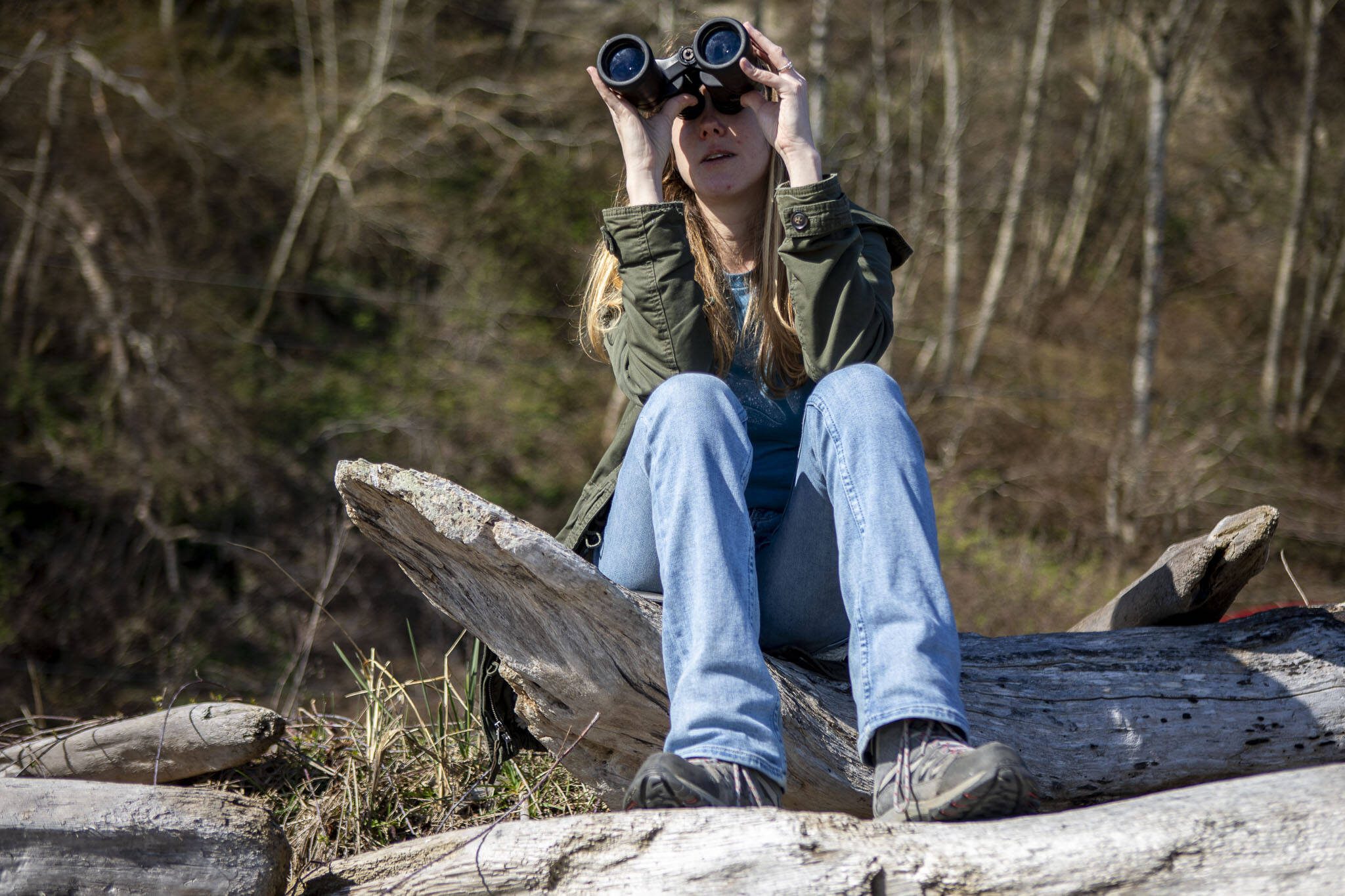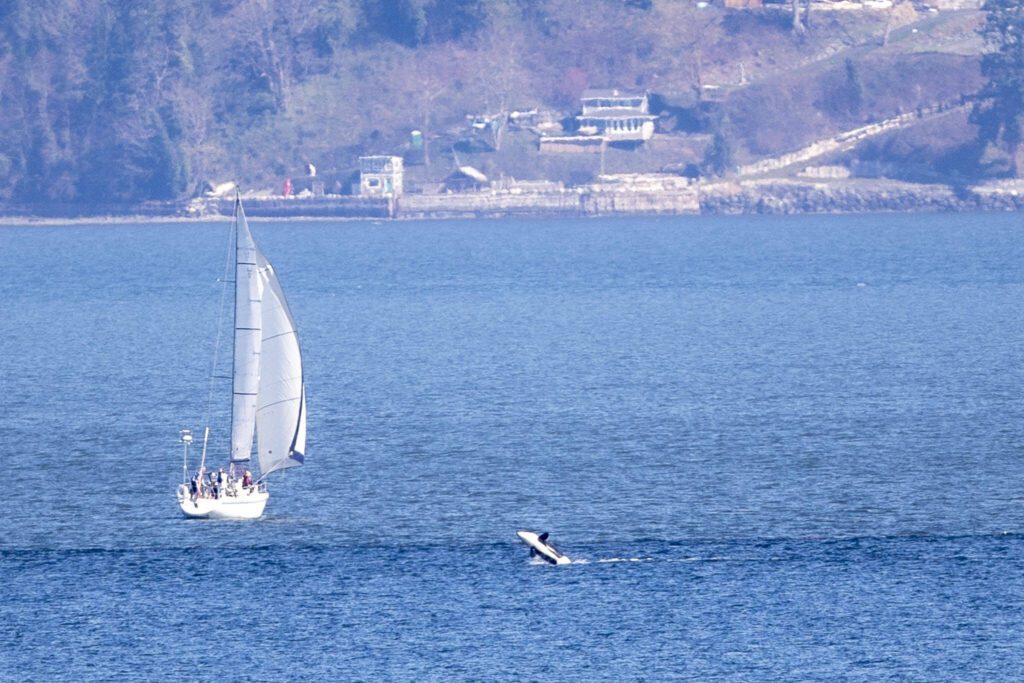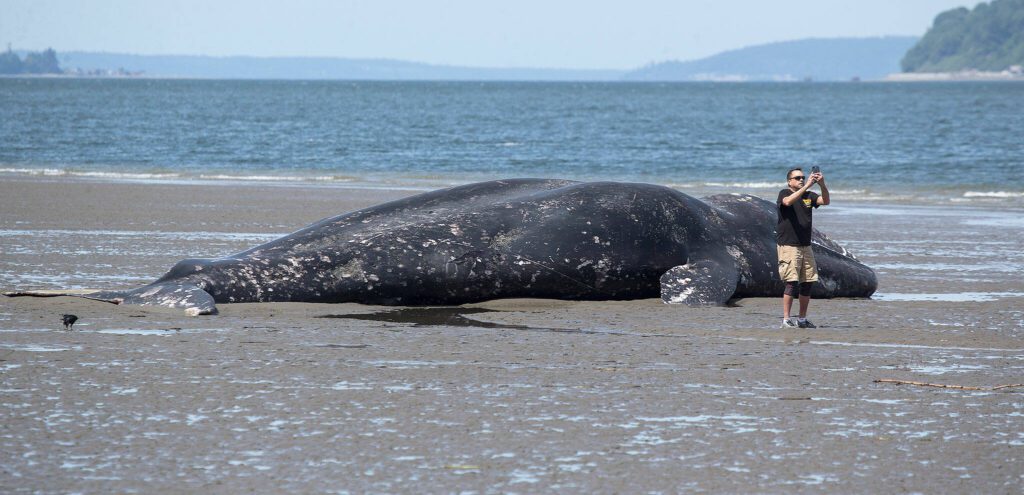LANGLEY — Rachel Haight’s shift with the Whale Sighting Network on Monday started with scanning Saratoga Passage, between Whidbey and Camano islands.
She was looking for North Puget Sound gray whales, and Wateredge Drive offers an elevated view of Sandy Point — a hot spot for the “sounders” who feed on ghost shrimp along the cove. Haight parked her gray Honda Civic on the side of the road and periodically checked her phone for potential updates from fellow whale chasers.
Haight patiently waited for the brigade of fog in front of Camano Island to lift, while she peered through her binoculars for whale spouts, or what seem like puffs of smoke on the water.
“There’s a blow,” she said, shortly after starting her stakeout.
She called her colleague, who was working remotely, and noted their activity, as well as where they may be headed. In a couple of minutes, her coworker posted the sighting on Orca Network’s Facebook page and notified large vessels nearby. As of this week, at least nine gray whales have been spotted in Puget Sound. Four of them appeared to arrive in early January — a month or two before they typically migrate to the Salish Sea.
Researchers worried their early arrival signaled larger concerns about Northern Pacific gray whales, as they detour to the Salish Sea from their northbound migration between Baja California and the Bering Sea. The exact reason for their timing is still a mystery. But live updates from whale chasers — who spend up to 40 hours per week tracking whales — continue to inform research on local marine mammals and give them extra space in high-traffic waters.
This month, the National Oceanic and Atmospheric Administration closed its five-year investigation into unusual deaths of the greater gray whale population that travel along the western coast of North America.
The agency declared an Unusual Mortality Event, or a significant die-off of the gray whales, from Dec. 18, 2018 through Nov. 9, 2023. During those years, the eastern Northern Pacific gray whale population dropped from 20,500 whales to 14,526.
In 2019, one of the deceased gray whales washed ashore in Everett.
The agency’s investigative team concluded ecosystem changes in the whale’s subarctic and arctic feeding areas caused most cases of malnutrition, decreased birth rates and increased mortality.
Over the past 30 years, more sounders appeared in the Salish Sea during periods of nutritional concerns, said John Calambokidis, a research biologist with the Cascadia Research Collective.
A group of six gray whales first arrived in Puget Sound between 1990 and 1991. Then members doubled from 1999 to 2000. By 2020, there were 20 sounders.
“It was driven by desperation,” Calambokidis said. “We think most of the sounders came and adapted this area when they were in search of a new feeding area.”
Most sounders usually leave by the end of May, but in recent years, some of the whales have stayed longer. And in 2022, one gray chose to remain in the Whidbey Basin for the year instead of tagging along with others in the northbound migration.
Longer stays in the Salish Sea increase risks for gray whales, who are especially vulnerable to vessel strikes because they migrate and feed in coastal areas.
On Sunday, a staff member with the Whale Sighting Network, Serena Tierra, noticed a bulk carrier anchored near Holmes Harbor was about to depart. Whale watchers confirmed two gray whales were in the southern portion of Saratoga Passage at the time, so Tierra made entries on the WhaleReport Alert System.
It’s unclear whether the vessel captain saw Tierra’s entries, but the ship slowed from 15 knots to 9.3 after she sent the alert.
“We all worked together,” said Haight, of the Whale Sighting Network. “It was nice to see.”
A majority of whale sighting reports originate from the Orca Network, which receives updates from staff and citizen scientists. Sightings help researchers find the whales, so they can attach sensors to the mammals for data collection.
Previously, researchers approached the whales by boat, using a pole to attach the suction cup sensor to the whale. Starting this year, researchers will solely use drones to drop sensors onto whales, Calambokidis said.
“We’re able to deploy more tags and do it with much less disturbance to the whale,” he said.
Researchers plan to start collecting data on the sounders next month, Calambokidis said.
Even outside of work, Haight clears her schedule to chase Puget Sound whales.
On Monday, Haight drove back and forth between Sandy Point and Hidden Beach to see a pack of orcas her friend Cindi Rausch had spotted near Hat Island. Her favorite whale, T46E, also known as “Thor,” was among them.
About three hours after the morning gray whale sightings, Haight parked on Wateredge Drive again. The street was lined with whale watchers, many holding binoculars and aiming cameras, with 400 mm and 500 mm lenses, toward the water.
Shortly after 1 p.m., the orcas gave a show, immediately greeted by cheers from their audience. One breached three times and another popped out of the water briefly to check out its surroundings, a move also known as a spy hop.
After hours of coordinating, driving and waiting, seeing the whales through binoculars or cameras is a win for whale watchers.
“Even though it’s been distant,” Rausch said, “we would call this a good day.”
Ta’Leah Van Sistine: 425-339-3460; taleah.vansistine@heraldnet.com; Twitter: @TaLeahRoseV.
Talk to us
> Give us your news tips.
> Send us a letter to the editor.
> More Herald contact information.































